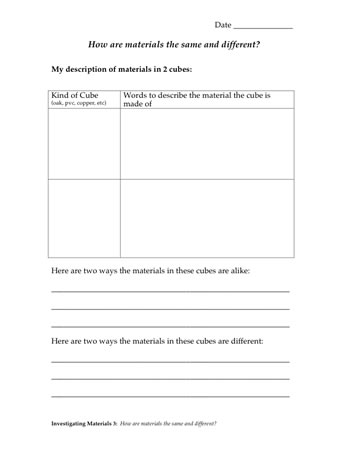How are materials the same and different?
Plan Investigating Materials 3
So far the class has considered a collection of miscellaneous objects: pencils, paper cups, spoons, and so on. Now it’s time to introduce some comparability into the inquiry. It’s time to meet … the cubes.
Students work with a set of 8 cubes, all the same size but each made of a different material. They each carefully examine two cubes and record their observations about the materials. Then they share their findings in a class list, describing all 8 cubes.
By the end of the investigation, students will be comparing and contrasting materials in terms of their physical properties.
Learning Goals
- to describe materials by their physical properties
- to compare and contrast materials according to their properties
| Sequence of experiences | ||
|---|---|---|
| 1. Ask the question | All Class | 10 Mins |
| 2. Investigate two cubes | Small Groups | 15 Mins |
| 3. List material properties | All Class | 10 Mins |
| 4. Make meaning | All Class | 10 Mins |
Materials and Preparation
For the class:- Post the investigation question in a place where all students can see it.
- Prepare a class table to record students’ findings; an example is shown in Step 3.
- A full set of 8 material cubes, each cube labeled with the name of its material:
- pine
- oak
- steel
- copper
- aluminum
- nylon
- PVC
- acrylic





